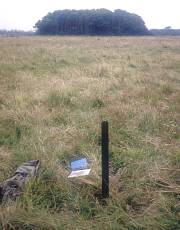Wetland archaeology
 The anaerobic conditions in permanently waterlogged soils prevent oxidation and chemical degradation of many types of archaeological evidence. The lack of oxygen also reduces faunal populations and inhibits root growth. Any chemically reducing environment formed may also produce compounds such as hydrogen sulphide, which are toxic to most organisms.
The anaerobic conditions in permanently waterlogged soils prevent oxidation and chemical degradation of many types of archaeological evidence. The lack of oxygen also reduces faunal populations and inhibits root growth. Any chemically reducing environment formed may also produce compounds such as hydrogen sulphide, which are toxic to most organisms.
Woodland hydrology
The type of vegetation cover will influence the quantity of water reaching the soil. Generally, woodland cover results in a drier soil than that of grassland. This is largely true for conifers which intercept a significant proportion of rain. Deciduous species behave similarly, though their effect on soil water is much smaller than conifers. The degree of interception varies with location, and the increase in water use by coniferous forest compared to grassland was found to vary from 15-20 % in the wetter north-west of Britain to 5-10 % in the south-east.
Grassland hydrology
The drying effect of grass should not be underestimated, as it is very efficient at abstracting moisture to a depth of up to 1.5 m. Grass begins to utilise soil moisture much earlier in the growing season and on some sites may produce a greater annual soil moisture deficit than adjacent tree cover. Unlike trees, however, grass roots do not extend for any significant distance laterally.
Seasonal changes in hydrology
A seasonal soil moisture deficit occurs when a soil water content falls in summer and is recharged in the winter. A persistent soil moisture deficit exists where the total amount of water a soil can hold (its field capacity) is not replaced during a single winter and is thus worsened during the following summer. Persistent moisture deficits are currently rare in the UK. The influence of trees on soil moisture is also seasonal and will therefore increase the amplitude of any water table fluctuations. The degree to which this happens will depend upon the vegetation cover, water availability, soil characteristics, local climate, site topography and management. Where buried archaeological evidence occurs within a zone of fluctuating water table, anaerobic conditions are unlikely to persist and both biological and chemical degradation may occur.
Managing water tables
Artificial site drainage will probably have a greater effect on the soil hydrology than any type of vegetation cover, where it occurs. Thus, a range of issues needs to be considered when a decision is to be made about the management of possible waterlogged archaeological deposits. Any land management which reduces either the water table or burial depth would increase the risks of loss to any archaeological (especially organic based) evidence present. However, it may also be possible to block any drains during drier periods or manage vegetation to reduce any seasonal fluctuation in water table.
